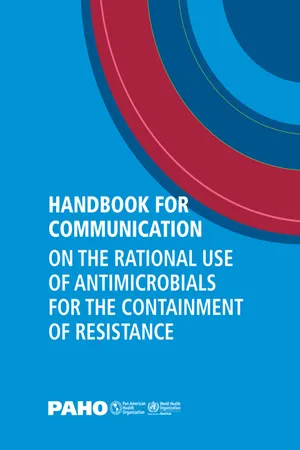
- 65 pages
- English
- PDF
- Available on iOS & Android
About This Book
The acquisition of antimicrobials without a prescription is a global concern. This practice is thriving in countries that lack adequate legislation or where regulations are not properly enforced.The Pan American Health Organization (PAHO) and its member states in the Region of the Americas approved the Global Action Plan on Antimicrobial Resistance, which recognizes antimicrobial resistance as a threat to global public health that requires a multisectoral response.To tackle antimicrobial resistance, a worldwide change in behavior is needed in terms of how these drugs are used and acquired. National approaches are required to address the indiscriminate use and over-prescription of antimicrobials, and to enforce regulations on prescription and acquisition practices.The objective of this communication handbook is to help communication professionals and health program officials develop strategies to raise awareness and promote the importance of the appropriate use of antimicrobials among different stakeholders; raise public awareness about the importance of obtaining antimicrobials with a prescription in order to achieve multisectoral collaboration to ensure compliance with laws and regulations on this issue; and promote a change in behavior regarding the appropriate use and acquisition of antimicrobials by everyone involved.The target audiences for this handbook are the general population (including adolescents, children, and child caregivers/parents of children), healthcare professionals (including pharmacists and pharmacy staff), and various stakeholders (government officials, professional societies, medical organizations, the private sector, local leaders, and health-influencers, among others).
Frequently asked questions
Information
Table of contents
- Preface
- Acknowledgments
- Background
- Objectives
- Social-ecological model for behavior change
- Analysis of public campaigns
- Understanding people’s behavior when acquiring antimicrobials
- Audiences
- Messages
- Strategies and activities
- Communication channels and tools
- Monitoring and evaluation
- References
- Appendix A
- Appendix B
- Appendix C
- Appendix D
- Appendix E
- Appendix F
- Appendix G